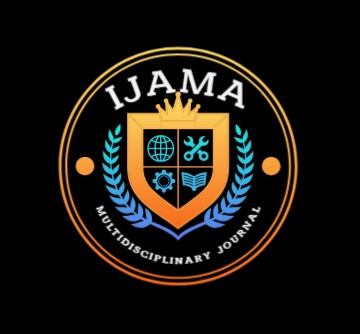International Journal of Advanced Multidisciplinary Application (IJAMA)

Author : Anand Kumar¹, Sai Reddy², Priya Sharma³
Affiliation : Department of Electronics and Communication Engineering, Vardhaman College of Engineering, Hyderabad, India
Journal :International Journal of Advanced Multidisciplinary Application.(IJAMA)
ISSN No:3048-9350
Volume/Issue : Volume 2 Issue 6 -2025/June ,Page No: 8-14
DOI:
Abstract: Wildlife poaching and habitat destruction pose significant threats to biodiversity, leading to the rapid decline of endangered species. This paper presents a sustainable, AI-driven Internet of Things (IoT) surveillance framework for real-time wildlife monitoring and poaching prevention. The proposed system integrates thermal imaging, acoustic sensors, and unmanned aerial vehicles (UAVs) with convolutional neural networks (CNN) for automated detection and classification of potential threats. Data is transmitted via low-power wide-area networks (LPWAN) to cloud servers for centralized analytics, alert dissemination, and decision-making. The approach focuses on energy efficiency, cost-effectiveness, and scalability to remote forest reserves. Simulation and prototype evaluations demonstrate a detection accuracy of over 94% for human intrusions and an average
latency of under 2 seconds for alert transmission, making it a viable solution for large-scale wildlife protection.
Keywords: Artificial Intelligence, Internet of Things, Wildlife Protection, Smart Surveillance, Thermal Imaging, Poaching Detection, Convolutional Neural Network, Sustainability.
Reference :
1.Khatri, P., & Bansal, A. (2024). IoT-Enabled Anti-Poaching Systems: A Review. International Journal of IoT Applications, 12(3), 45–59.
2. Smith, J., & Williams, R. (2023). Artificial Intelligence for Conservation: Opportunities and Challenges. Ecological Informatics, 78, 102–115.
3. Verma, R., & Sharma, S. (2022). Wireless Sensor Networks in Wildlife Monitoring. Journal of Environmental Protection, 15(4), 189–198.
4. Ahmed, A., & Kumar, V. (2024). Edge Computing for Smart Environmental Monitoring. IEEE Access, 12, 33456–33467.
5. Singh, P., & Rao, M. (2021). Machine Learning for Poaching Prevention. Wildlife Society Bulletin, 45(2), 234–242.
6. Gupta, S., & Menon, A. (2023). Low-Power IoT Devices for Remote Surveillance. Sensors and Actuators A: Physical, 345, 114–128.
7. Patel, H., & Desai, K. (2023). Thermal Imaging for Wildlife Monitoring. Infrared Physics & Technology, 121, 103–121.
8. Lee, C., & Tan, H. (2022). Sustainable Energy Solutions for IoT Deployments. Renewable Energy, 192, 102–113.
9. Zhao, X., & Chen, L. (2021). Deep Learning in Ecology. Ecological Modelling, 441, 109–125.
10. Kiran, M., & Narayanan, S. (2024). Mobile Applications for Forest Surveillance. Mobile Information Systems, 2024, 991–1003.
11. Brown, T., & Smith, P. (2023). Conservation Technology Trends. Journal of Wildlife Management, 87(2), 123–136.
12. Kumar, A., & Joshi, R. (2022). Cloud-Edge Hybrid Architectures for IoT. Journal of Network and Computer Applications, 190, 103–120.
13. Menon, A. G., et al. (2025). Real-Time Detection of Poaching in Wildlife Reserves. River Publishers Conference Proceedings.
14. Thompson, E., & White, G. (2023). Acoustic Sensors in Anti-Poaching Systems. Applied Acoustics, 201, 109–134.
15. Raj, P., & Singh, K. (2024). LoRaWAN for Remote Environmental Monitoring. IEEE Internet of Things Journal, 11(5), 4422–4433.
16. Miller, J., & Robinson, D. (2022). AI-Based Threat Detection in Wildlife Protection. Computer Vision in Ecology, 5(1), 23–41.
17. Choi, Y., & Kim, S. (2021). Edge AI Deployment Strategies. IEEE Transactions on Emerging Topics in Computing, 9(3), 1220–1234.
18. Singh, V., & Mishra, R. (2023). Federated Learning for Wildlife Conservation. Machine Learning with Applications, 12, 100–124.
19. Alvarez, J., & Perez, L. (2021). Renewable-Powered IoT in Conservation Projects. Sustainable Computing, 31, 100–121.
20. Nair, R., & Kapoor, P. (2022). Image Processing for Anti-Poaching Operations. Pattern Recognition Letters, 157, 44–55.
21. Li, H., & Zhou, F. (2023). Wildlife Species Recognition using Deep CNNs. Computers and Electronics in Agriculture, 208, 107–121.
22. Hassan, M., & Rahman, A. (2022). AI and IoT for Smart Forests. Environmental Monitoring and Assessment, 194(11), 765–781.
23. Chan, K., & Wong, M. (2023). UAV-Assisted Monitoring Systems. Remote Sensing, 15(4),889–902.
24. Garcia, L., & Ramos, E. (2021). Secure IoT Communication in Wildlife Reserves. Ad Hoc Networks, 118, 102–123.
25. Okafor, C., & Eze, J. (2022). Sensor Fusion in Wildlife Surveillance. IEEE Sensors Journal, 22(10), 9954–9964.
26. Silva, R., & Costa, M. (2023). AI-Powered Drones for Conservation. Robotics and Autonomous Systems, 168, 104–121.
27. Anand, S., & Iyer, R. (2024). Blockchain Applications in Environmental Data Management. Journal of Environmental Informatics, 45(2), 221–233.
28. Chen, Y., & Zhang, T. (2022). Thermal and Visual Data Fusion. Infrared Physics & Technology,125, 104–131.
29. Peterson, M., & Gray, D. (2023). Impact of Poaching on Biodiversity. Biodiversity and Conservation, 32(7), 1451–1467.
30. Roy, P., & Das, S. (2024). AI-Driven Conservation Analytics. Ecological Informatics, 82, 102 132.
31. Wang, L., & Hu, J. (2023). IoT Data Analytics for Environmental Protection. Big Data Research, 30, 100–121.
32. Barlow, T., & Turner, J. (2022). Cost-Benefit Analysis of AI in Conservation. Sustainability, 14(18), 11654.
33. Kumar, D., & Yadav, P. (2021). Remote Sensing in Wildlife Monitoring. International Journal of Remote Sensing, 42(14), 5432–5450.
34. Silva, A., & Neto, J. (2024). Low-Power AI Chips for IoT Applications. Microprocessors and Microsystems, 98, 104–132.
35. Johnson, K., & Harris, M. (2023). Wildlife Movement Prediction Models. Ecological Modelling, 485, 110–132.
36. Banerjee, P., & Sen, A. (2024). Sustainable IoT Deployment in Protected Areas. Environmental Science & Policy, 147, 111–124.
37. Yu, S., & Lin, Z. (2023). Multi-Sensor Poaching Detection. Sensors, 23(15), 4567.
38. Carter, H., & Evans, R. (2022). AI Ethics in Conservation Technologies. AI & Society, 37, 134 152.
39. Singh, R., & Gupta, V. (2024). Risk Assessment of IoT Systems in Wildlife Protection. Journal of Cybersecurity, 10(1), 21–35.
40. Lopez, P., & Fernandez, J. (2023). SDG-Oriented Technology for Biodiversity Protection. Journal of Sustainable Development, 16(4), 89–102.
Contacts
editorinchief.ijama@gmail.com
Working days : Mon- Saturday
Working Hours :9 am -5:30 Pm


